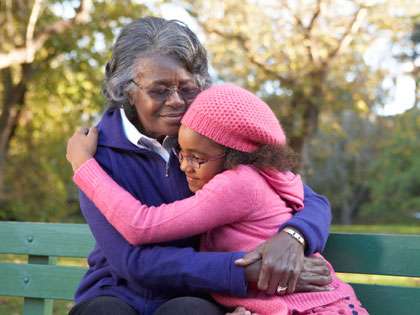This report reveals the daunting predicaments that face older women who are trying to raise their own grandchildren. It was made available by Futurity, a website that showcases the latest research by top universities, and was originally posted there by the University of Washington on Dec. 21, 2015.
Increasing numbers of grandmothers across the United States are raising their grandchildren, many of them in poverty and grappling with a public assistance system not designed to meet their needs.
For a new study, researchers interviewed 77 African American grandmothers living in some of the poorest areas of south Chicago. The findings underscore the challenges these caregivers face, including dealing with divided loyalties between their grandchildren and their own children, navigating the complications of getting state resources they desperately need and sacrificing their own well-being to take care of their grandchildren.
The majority of the grandmothers interviewed, who ranged in age from 38 to 83, had annual incomes of less than $15,000, though more than half were employed. Fifty-eight were raising children in informal arrangements and were ineligible for funding under the state child-welfare system. Benefits available to parents were also often out of reach, and public assistance aimed at seniors was inadequate to cover the costs of child-rearing.
“They fell through the cracks in ways that have real ramifications for them,” says LaShawnDa Pittman, assistant professor in the American ethnic studies department at the University of Washington.
And their ranks have swelled. The number of children living with a grandparent in the United States has increased by 22 percent since 2000, rising sharply during the Great Recession from 2007 to 2009. The rise can be attributed to a host of factors, including incarcerated parents and unemployment, inadequate mental health services and substance abuse, Pittman says.
Some parents tried to take their child away from a grandparent to get subsidized housing or other resources the child was eligible for.
Grandparents are now the primary caregivers for more than 2.9 million children nationwide, and two-thirds of grandmother-headed households live at or below the federal poverty line. Black children are twice as likely to live with grandparents or other relatives as are white and Hispanic children, but since the Great Recession, white grandparents are now the fastest-growing subset of grandparent-headed households.
The new paper, published in the Russell Sage Foundation Journal of the Social Sciences, highlights the strategies grandmothers devise to keep grandchildren in their care without jeopardizing subsidized housing, such as keeping children’s names off leases to avoid being disqualified for senior housing. In some cases, grandmothers are not getting benefits available to them or have to jump through unnecessary hoops to access services because they are misinformed.
In most situations, parents either failed or refused to contribute financially to their children’s care. In one case, a daughter left her mother to care for her two-year-old daughter without transferring the child’s public assistance payments—leaving her mother without any formal support or income. And in some cases, parents removed or tried to remove their children from a grandmother’s care to get subsidized housing or resources the child was eligible for.
Child-Care Consumers
Child care is another challenge. One grandmother quit her job because she couldn’t find child care and had to rely on unemployment income and help from friends. Another was prevented from seeking a job because she couldn’t afford child care. She couldn’t get subsidized care since she wasn’t her grandchild’s public assistance payee, and transferring those payments might have jeopardized the child’s safety if her mother took her back to claim the benefits.
“We often think of grandmothers as child-care providers, but when they’re parenting children, they’re also child-care consumers,” Pittman says. “So how do they acquire child care for their grandchildren when they’re normally the people that parents leave the children with?”
“I was interviewing grandmothers who were raising grandchildren from recliners because they could barely get around.”
— LaShawnDa Pittman, PhD
Pittman conducted the research while pursuing a doctoral degree at Northwestern University. She initially set out to investigate the support networks available to inner-city children, and grandmothers kept coming up in her research. She spent the better part of four years visiting grandmothers in their homes, accompanying them to doctor’s appointments and going to church with them.
Pittman was struck by the magnitude of their poverty and the poor health many were in—one grandmother in her 40s had her granddaughter leave the front door unlocked because she was unable to get down a flight of stairs to open it.
“I was interviewing grandmothers who were raising grandchildren from recliners because they could barely get around,” Pittman says. “I was talking to 40- and 50-year-olds who could barely walk, for a variety of reasons.”
But many grandmothers also showed incredible resilience.
“Even though raising their grandchildren is really hard, they wouldn’t have it any other way,” Pittman says. “One of the big things I heard was, ‘My grandbaby won’t end up in the system. If that means I’ve got to make these kinds of sacrifices, that’s just what it’s going to be.’”
Some efforts are trying to address the shift in demographics. Kinship Navigator Programs have been established in about five states, including Washington, to help connect intergenerational caregivers with services and deal with complex family dynamics.
But while the kinship programs provide a valuable service, more resources are needed to help the millions of grandparents struggling to raise their grandchildren.
“Our current safety-net programs aren’t set up to deal with this increasingly common situation,” Pittman says. “Understanding people’s challenges and experiences is the first step to rethinking how we might better serve some of our most vulnerable households.”
The National Science Foundation and the Administration for Children and Families, US Department of Health and Human Services, funded the work.



